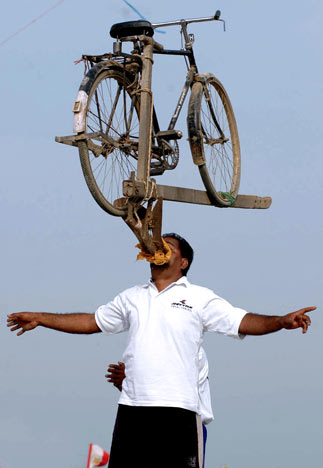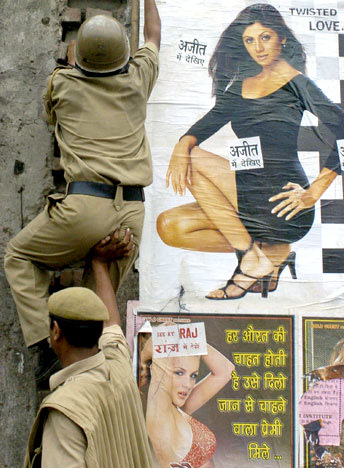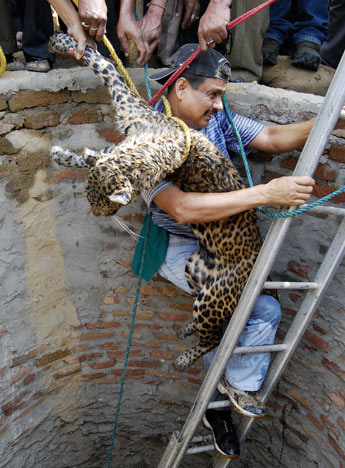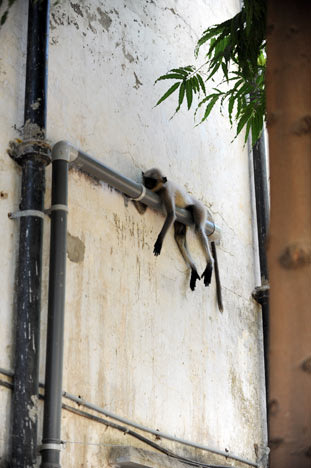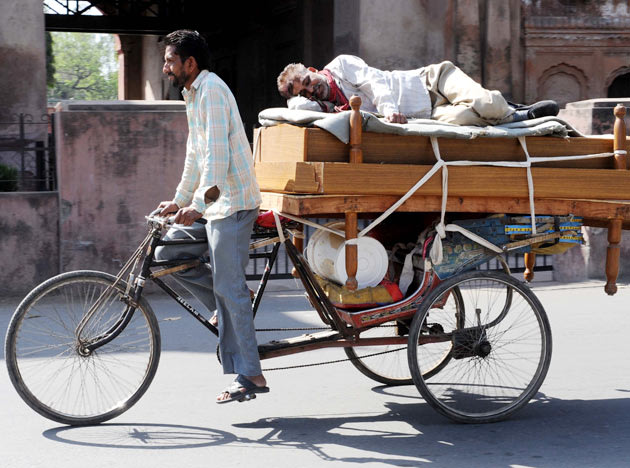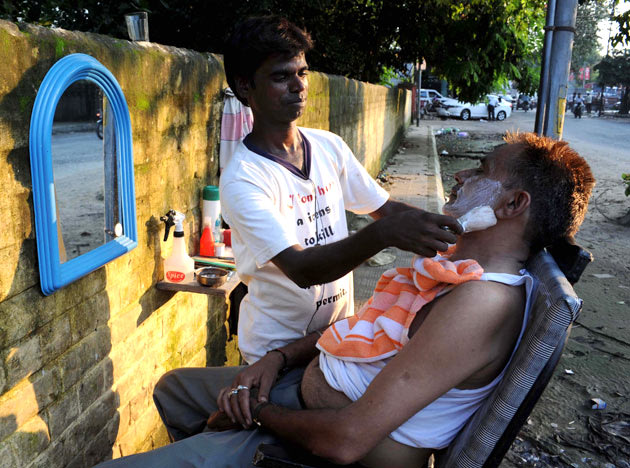A Hindu devotee dressed as a monkey god smokes before taking part in a religious procession to mark the Gajan festival in Kolkata (April 12, 2012). Devotees offer prayers during the month-long festival in hopes of winning the god's favour and ensuring fulfilment of their wishes, as the festival ends on the last day of the Bengali calendar year on April 13.
Boys ride a motorbike on their way back home after taking a bath in a canal at Chachura village, in the northern Indian state of Uttar Pradesh April 4, 2012.
A woman pumps mustard oil in the right ear of a two-year old girl, who according to her mother is suffering from Mithua or Protein-Energy Malnutrition (PEM), along a roadside in Kaudihar town in the northern Indian state of Uttar Pradesh April 8, 2012. The woman claims she possesses divine powers, tries to cure PEM by pouring mustard oil in ears and pumps them with an aluminuim rod using her mouth.
A boy performs a stunt with the rim of a bicycle during a religious procession to mark the Hindu Navratri festival in Jammu March 31, 2012. Devotees worship various forms of Hindu goddesses during the festival, whose name literally means nine nights.
An Indian Hindu devotees dressed as Lord Shiva rides on a motorcycle before a Maha Shivaratri procession in Amritsar on February 20, 2012. The festival of Maha Shivaratri is marked with fasting and prayer offerings in a night long vigil.
Children dressed as Mahatma Gandhi arrive on a bus to take part in a peace march in Kolkata January 29, 2012. Four hundred and eighty-five children from the Training Resource and Care for Kids (T.R.A.C.K.S), a charity for single mothers and children living without support at railway stations, took part in a peace march on Sunday in an attempt to create a Guinness World Record for being the largest gathering of people dressed as Mahatma Gandhi.
A Hindu devotee pours milk over a cobra during a Nag-Panchami ritual at the Shiva Temple in Amritsar on August 4, 2011. The Hindu festival of Nag-Panchami, observed during the monsoon and sees prayers and tributes to snakes, is observed by many as the day of victory of Hindu God Lord Krishna over the Kaliya snake leading to Krishna also being known as 'Kaliya Mardan'.
A Sufi Kalandar (wandering ascetic) performs an act of self torture during devotion at the annual Urs (death anniversary) of Sufi saint Khwaja Moinuddin Chishti in Ajmer on June 2, 2011. Also known as Gharib Nawaz or 'Benefactor of the Poor', he established the Chisti order on the Indian subcontinent and is the most famous Sufi saint of the Chishti Order in the region.
Ramu, a 7 months old monkey, scratches as he rests with his dog friend Kalu in Sonahat, 29 May 2003 an Indian village on the border with Bangladesh. Indian troops on the border with Bangladesh are getting some unusual help in their patrols as Ramu, sitting on his canine friend's back accompanies troops each day on patrol.
An Indian man participates in a bicycle balancing competition during 71st Rural Olympics Games 2006 in the village of Kila Raipur in the northern Indian state of Punjab, on 18 February 2006. The games are a composite of sports and cultural events, including bullock cart race, kabaddi, loading and unloading of tractor trailer and wrestling, as well as musical and dramatic presentaions.
An Indian riot policeman helps a fellow policeman as he climbs a wall adorned with movie posters while taking positions during a violent demonstration in Gurgaon, a New Delhi suburb, 26 July 2005. Indian riot police and workers of the Indian unit of Japan's Honda Motor clashed for a second day on New Delhi's outskirts after nearly 130 people were injured in pitched battles on 25 July, officials said.
Assam state Zoo veterinarian Bijoy Gogoi carries a tranquilised leopard from a well in Guwahati on March 28, 2009, after the animal fell into the well in a village on the outskirts of the north-eastern Indian city. The fully grown female leopard was later taken to the Guwahati Zoo, becoming the second leopard to have been rescued from this particular area of the city in a month. Earlier another leopard was rescued on March 15.
An elephant crosses a railway track which runs through the Mahananda Wildlife sanctuary on the outskirts of Siliguri in west Bengal on September 16, 2010.
An Indian langur monkey takes a nap on a PVC pipe in Ahmedabad on October 18, 2010.
An Indian dancer performs during the press presentation of the show "India" on December 15, 2009 in Frankfurt am Main. The show, produced at a cost of 7 million euros with 75 dancers, artists and musicians, will start on December 17 in Frankfurt and the will tour to Hamburg, Berlin, Munich, Vienna (Austria) and Brussels (Belgium).
A man takes a nap on a bed being transported by a cycle rickshaw driver in Amritsar on March 7, 2010.
An Indian barber Shahrukh Khan (L) shaves a customer's beard at a roadside barbershop in Amritsar on September 12, 2011.
 Born on September 17, 1950 in Vadnagar, 100km from Ahmedabad Narendra Modi is the third child of Damodardas Modi and Hiraben.
Born on September 17, 1950 in Vadnagar, 100km from Ahmedabad Narendra Modi is the third child of Damodardas Modi and Hiraben.


















